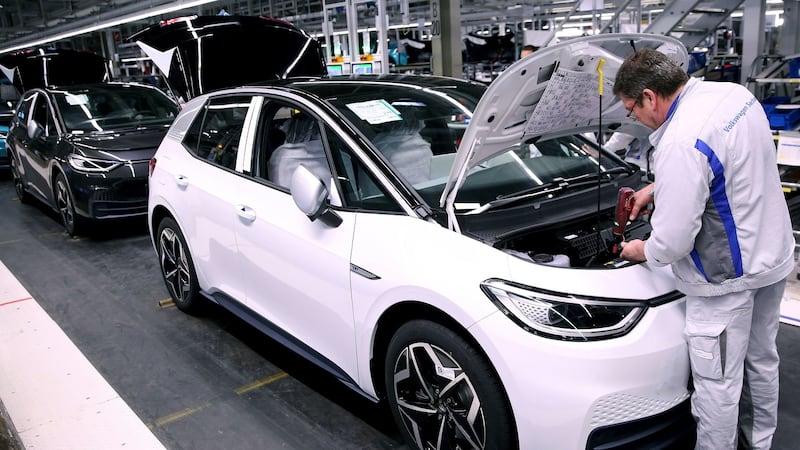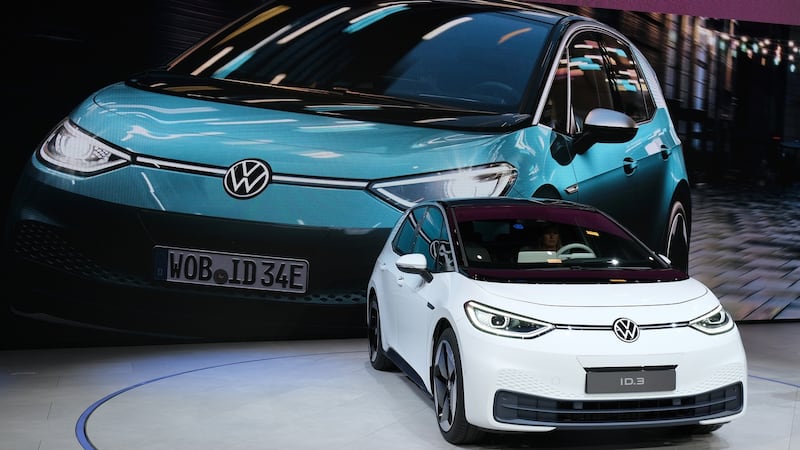Volkswagen's ID.3, its all-important electric hatchback and the car that may take over from the evergreen Golf as the default VW, will arrive in Ireland with a starting price of €33,625.
That's taking the €10,000 VRT rebate and SEAI grant into account, and is the base price for the initial ID.3 1st model - a limited edition version built for those who got their orders in early. Numbers will be severely limited until the factory in Zwickau, Germany – where the ID.3 is built – gets up to full speed. When it does, VW says that it has the capacity to build some 330,000 ID.3s each year.
Basic equipment will include 18-inch alloy wheels (called ‘East Derry’ wheels in VW’s brochure, but we suspect there’s no Derry Girls connection, at least not yet), a large ‘Discovery’ multimedia touchscreen, a leather steering wheel, heated seats, adaptive cruise control with traffic stop-and-go, two-zone climate control, and LED headlights.
There will also be an ID.3 1st Plus, priced from €40,595 after grants, and an every-option-fitted ID.3 1st Max, priced from €47,545 after grants.
All three models will come with a 58kWh battery pack, which will give the ID.3 a range of roughly 420km, although VW admits that could fall to 330km in real-world conditions. A more affordable version with a smaller battery and shorter range will be available in 2021.

The car will come with a huge number of high-tech options, including LED lights that ‘look’ at you as you approach the car, and clever voice control that will open the panoramic roof blind if you say ‘show me the stars.’ However, VW is still racing to sort the car’s software, which has been the subject of numerous delays. The initial 1st-spec cars will actually ship with incomplete software, so some of the functions for the internet-based App Connect system, and the top-spec Max version’s augmented reality heads-up display will not be ready.
Owners will be given a full software update, which will be available, according to VW, in the first quarter of next year, but although the ID.3 will eventually be able to receive wireless, over-the-air software updates, this first one will require a visit to a dealer. VW has justified the decision to ship the cars with incomplete software, saying: “We have so much fun driving the car, and there are these features that are not yet at the level where we say we want to give it to our customers. They are not yet up to VW standards. And so, we gave we decided to give our pre-bookers the option to still have the car and enjoy what we enjoy every day. And of course that comes with the promise that we will update the car for them.”

Other options will include a heat-pump heating system, which can warm the cabin up more efficiently in winter, but which will be initially only available in colder-climate markets, and, eventually, a ‘vegan’ option that replaces interior leather trim. There will also be a 77kWh battery option, which will push the range of the ID.3 close to 600km, but it weighs so much that models with that battery will be four-seat models only, as the weight of a fifth passenger would be too much.
As well as promising that the ID.3 will be produced in a carbon-neutral factory, VW is also claiming that the car will be very recyclable. "After the car's lifetime, Volkswagen aims to take the car back, and recycle it as a whole, and put it all back into the material loop" the car's designer, Klaus Bischoff, told The Irish Times. "We are also looking deeply into the second life of the batteries, of course."
One big question is how the ID.3 will live alongside the existing Golf. Although for now more expensive than a Golf, the ID.3 is a similar overall size to the big-selling family hatchback, and VW has previously spoken of the car being its third great revolution in design and engineering, following along from the Mk1 Golf and the original Beetle. So will the ID.3 eventually supplant the Golf? The answer seems like yes, but Bischoff and VW are carefully choosing their corporate words, mindful of not undermining the brand's cash-cow. "The world wide markets are at different stages of electrification" said Bischoff. "The Golf is, of course, making its own move into electrification and hybrid power. The GTE Golf already does a good job of combining both worlds. And these cars will live on, for another long period of time. There will be a strong move to electric products but under the circumstances right now it's hard to predict what the relative market shares will be."
Bischoff also spoke of the possibility of an eventual sporty GTI-style variant of the ID.3 (which VW has more or less confirmed, possibly badged as an R model) and the benefits of the car’s over-the-air software updates and lack of physical cabin buttons (“In the past you had a physical radio with physical buttons, and if you wanted to upgrade that you had to rip the whole thing out and throw it away. Now you can download updates and applications over the air, so over its lifetime the car will be more mighty, and more intelligent than ever before.”)
VW will have to surmount the difficulties of building the ID.3 under social distancing conditions, working out its final software issues, and bringing it to customers in the midst of an economic downturn, all while trying to convince eco-friendly buyers that it has left behind its emissions-cheating of the dieselgate saga. That’s no easy set of tasks to navigate.












